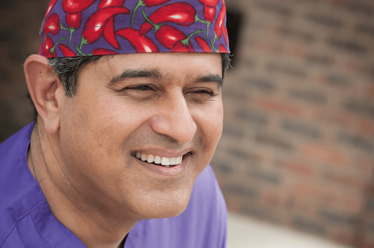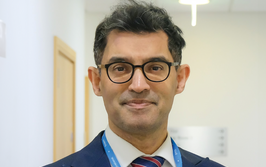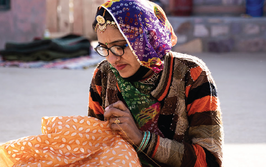Ignore the “Gurus” and Follow the Evidence
Sitting Down With... Sheraz Daya, Ophthalmologist and Medical Director of Centre for Sight in the UK

What gets you going in terms of research?
It’s really curiosity that motivates me – asking a question or encountering a problem, and then going out there to find the solution. I have a considerable dislike for dogmatic thinking and process and confess that when I find flaws, I do challenge them using fundamentals as a basis. The use of trifocal diffractive lenses in post corneal laser surgery patients is one example; it is something that some “gurus” say should not be done as the corneal and lens optics are not compatible with each other. But we perform this in carefully selected cases – with phenomenal outcomes.
What’s wrong with ophthalmology today? What’s right?
I am an optimist! I do not believe there is anything terribly wrong with ophthalmology today, with the exception of things like refractive surgery being hijacked and treated as a widget by high-volume providers. There, the care provided, with its lack of continuity and pure algorithmic process, forgets the patient and focuses on volumes, targets and profits. This is a sure recipe for trouble and sadly taints the reputation of refractive surgery which despite this, is excellent and better than it ever has been. Otherwise, I believe the specialty of ophthalmology is wonderful and often leads the way in medicine.
LASIK is 25 years old now, and you pioneered its use in Europe. Did you think you’d still be using it 25 years later?
The predecessor of LASIK was automated lamellar keratectomy, which used a manual microkeratome to resect a 130 or 160 µm free flap, followed by a refractive cut using the same device. I had performed this on two myopic patients (one, -8.00 D, the other -12.00 D) in New York and was amazed at the outcomes. Using a laser to perform the refractive cut was far more elegant and much more accurate. I just knew that LASIK was here to stay when I saw the outcomes of my first patients.
Back then, what we were doing was rather elementary and we had a lot to learn about optics. Today, we have a far better understanding, and technological advances mean that modern day lasers provide patients with very predictable and accurate outcomes. The advent of femtosecond laser flaps has also made a huge difference. The terror of having a problematic flap and having to pacify a distressed patient has gone, which was the major motivator for us taking the plunge in 2004 and acquiring UK’s first IntraLase laser. Again, I knew that for reasons of safety alone this would become the gold standard.
What do you think refractive surgery will look like in 10 years’ time?
Ten years is a relatively short time and much of what might be available in 10 years is probably at the late stages of development now. LASIK will still be here, and perhaps it will be performed more commonly once we develop a better understanding of dry eye and nerve re-innervation. SMILE is in its infancy and like so many innovations, this will go through a period of evolution and further development. Reversibility of surgery is very attractive, and for this reason, I believe that phakic IOLs will grow in prevalence. Allograft or synthetic collagen corneal inlays also follow the theme of reversibility and may well become more prevalent too.
For those in the older age group, lens exchange will remain the dominant procedure – what will change is the type of lenses being offered. The Holy Grail is a reliable accommodative lens, but moving parts within the eye have been an issue so far and I expect there will be something very simple in terms of innovation that will come from in from left field that will provide a solution.
In 2030, given the advances in stem cell biology, will corneal transplants be the exception, rather than the rule?
Corneal transplantation has changed considerably over the last 15 years and many of those changes are thanks to technology derived from refractive surgery! Microkeratomes enabled Descemet’s stripping endothelial keratoplasty (DSAEK), which ended up evolving into Descemet’s membrane endothelial keratoplasty (DMEK). I expect both procedures will be replaced by therapeutic modalities, such as corneal cell therapies with Rho Kinase inhibitors.
Stromal substitutes are already in development and I expect synthetic corneas will become more commonplace. Stem cell treatments will have a role, so long as the correct concoction of cytokines and growth factors can be found to get stem cells recruited from the bone marrow and provide the necessary repairs required. So yes, transplants will reduce in number, but will still be performed in many cases for many years to come, particularly in cases of trauma and where initial reconstruction of the front of the eye is required.
Can stem cell treatments scale – or will cost considerations keep them a niche offering?
At the moment, we are at the stage of stem cell treatment being conducted by some sort of procurement, tissue engineering ex-vivo and then transplantation. In 20 years’ time, this will seem quite medieval, once there is a better understanding of wound repair and the role of cytokines in recruiting or stimulating host stem cell recruitment and production.
Why ophthalmology?
Thanks to our surnames being close together alphabetically, John Chang and I were in the same group throughout medical school. John was determined to do ophthalmology and he convinced me to join him and watch cataract surgery during one of our rotations. Even though it was 1982 and fairly old-fashioned surgery watching our Professor, Peter Eustace, operating sat down and using microscopes made me realise that this is was it. It looked so civilized, precise and patients were ecstatic the next day – quite different from other surgical specialties.
From Dublin to Minneapolis and New York to London’s Harley Street: what have been the most important lessons you’ve learned along the way? Who were your mentors?
There is so much to gain by travelling from one country to another, one realizes that there is so much variety in thought, culture and educational methods with considerable benefits from cross-fertilization.
Actually, my travels started earlier – I was initially brought up in Tanzania and then went to a tough evangelical Christian boarding school in South India from age 10 to 15. I then came to school in the UK and then over to medical school in Dublin. My first mentor was Professor Kevin O’Malley under whom I learned about research and spent a few weeks learning how to combine Chlorambucil to a monoclonal antibody. I spent one year in Belfast as a house officer at the Royal Victoria Hospital and then moved to the USA to do a residency in Internal Medicine at a hospital not far from Wall Street and Chinatown in New York.
I was then fortunate to get into Ophthalmology after I’d become board certified in internal medicine. This was when I met the person who had the greatest impact as a mentor. David Paton was the chairman of the program I went to in New York. He is well known for conceptualizing and getting Project Orbis off the ground. He also developed the Cullen Eye Institute in Houston, Texas as well as King Khaled Eye Hospital in Saudi Arabia. Mediocrity was not a word in David Paton’s vocabulary and he had considerable influence and altered how I thought – getting me to stoke my imagination and then go out and make it happen!
I was very fortunate to be accepted by Edward J. Holland for a cornea, anterior segment and refractive surgery fellowship at the University of Minneapolis. He was (and still is) a phenomenal educator and great to have as a mentor and friend. We have remained in close contact over the last two decades and collaborated in several areas, particularly ocular surface reconstruction.
Another mentor is Richard L. Lindstrom, under whom I spent 6 months as a fellow and had exposure to refractive surgery at the cutting edge. I had the opportunity to do my first excimer laser procedure thanks to Emmet Carpel who let me operate on his patient.
Coming to the UK was a major change – and one that I had never planned. (I intended to remain in the US.) My predecessor, Tom Casey, who was head of the Corneoplastic Unit and Eye Bank at Queen Victoria Hospital in East Grinstead had sadly died a year earlier. My brother (an ENT specialist) saw the misplaced advertisement for the job and suggested I apply. Although I was settling well in New York City, the job description for East Grinstead was almost like it had been written for me, and me alone, with the requirement to deal with very difficult corneal cases, re-grafts and severe ocular surface problems. The presence of a tissue engineering laboratory on-site was music to my ears. I was lucky enough to get the job, mainly because all other eight applicants had withdrawn!
Moving from Manhattan to East Grinstead was quite daunting as I was 33 years old, a lone consultant, in a very well-known unit. I am eternally thankful for the support from my colleagues, as well as hospital administrators who gave me considerable freedom to develop and grow the unit using a very American ethos in terms of patient-centric care, with a considerable number steps in the patient care pathway being carried out by technicians and nurses.
I had the opportunity to put in place the lessons from David Paton who felt that doctors were precious resources and should dedicate themselves to doing the “doctoring” i.e. making a diagnosis, treating and performing surgery, leaving technical aspects to others. This worked well and we became very productive at East Grinstead on many fronts, from delivering exemplary corneal surgery and care, through to training international fellow and conducting major limbal stem cell transplantation research, and in liaison with the Blond McIndoe Research Centre, the development of ex-vivo stem cell transplantation. The department also grew with the appointment of the hugely gifted oculoplastic consultant surgeon, Raman Malhotra. I am very pleased to see that the ethos and culture of the unit at East Grinstead has continued since my departure. It is a legacy of which I am very proud and great to see the unit in the able hands of my ex-fellows, Damian Lake and Samar Hamada.
Is private practice as (or more) conducive to research and innovation as a University Hospital?
Centre for Sight was established 20 years ago as a private unit within the Queen Victoria Hospital with the goal of making laser eye surgery – in particular, LASIK – credible, and to also provide the opportunity for NHS patients to avail of this type of care where medically required. Like the Corneoplastic Unit, the Centre for Sight has grown considerably over the last 20 years and we now have 2 surgical sites and a satellite consultation facility in London.
Having worked in both areas in parallel, I am very thankful for the opportunities provided through the Queen Victoria Hospital at East Grinstead. It was far from being a University Hospital, but it nevertheless had the elements of academia, having been a pioneering hospital that took care of injured fighter pilots during and after World War II. The hospital under the incredible leadership of Sir Archibald McIndoe, Sir Benjamin Rycroft and others, who pioneered new techniques in plastic, maxillofacial surgery and corneal surgery. Although there was no compulsion to be academic, the concentration of very intelligent and pioneering individuals established a culture of innovation and development – and I am very thankful to have been placed in this environment.
The areas of innovation in private practice are quite different and there are similar opportunities however with more involvement with industry. I am a consultant to a number of companies and provide them with advice on innovation and direction. Having excellent diagnostic and therapeutic facilities at Centre for Sight makes the whole process much easier with everything is under one roof, variables can be standardized and data collection complete. I miss the access to basic science laboratories and have had to do less work on transplantation techniques on the ocular surface, but now deal with laser refractive, lasers and lens surgery.
What’s wrong with ophthalmology today? What’s right?
I am an optimist! I do not believe there is anything terribly wrong with ophthalmology today, with the exception of things like refractive surgery being hijacked and treated as a widget by high-volume providers. There, the care provided, with its lack of continuity and pure algorithmic process, forgets the patient and focuses on volumes, targets and profits. This is a sure recipe for trouble and sadly taints the reputation of refractive surgery which despite this, is excellent and better than it ever has been. Otherwise, I believe the specialty of ophthalmology is wonderful and often leads the way in medicine. It is a great field which no longer needs to be positioned in a multi-specialty hospital, and is better placed and more efficient as stand-alone units. The specialty is small but highly effective and because of size and sometimes envy by medical colleagues, ophthalmic departments have little or no influence.
It’s now over a quarter of a century since the first clinical LASIK procedures were performed. What was it like to be there at the start of a phenomenon? Did you expect to still be performing it 25 years later?
Yes, it’s a long time since LASIK first started and I was privileged and fortunate to have been amongst the first in the UK and Europe. The predecessor for the procedure was Automated Lamellar Keratectomy (ALK) which used a manual microkeratome to resect a 130 or 160 µm free flap, followed by a refractive cut using the same device. I had performed this on two patients (one, a -8.00 D myope, the other a -12.00 D myope) in New York and was amazed at the outcomes. Using a laser to perform the refractive cut was far more elegant and much more accurate. I just knew that LASIK was here to stay when I saw the outcomes of my first patients in the UK.
However, back then, what we were doing was quite elementary and we had a lot to learn about optics. Today with much better understanding and technologic advances lasers provide patients with very predictable and accurate outcomes often with gains in best corrected visual acuity. The advent of femtosecond laser flaps has also made a huge difference. The terror of having a problematic flap and having to pacify a distressed patient has gone. This was the major motivator for us taking the plunge in 2004 and acquiring UK’s first IntraLase laser. Again I knew that this would become the gold standard.
If you could give a young Sheraz Daya some advice, what would it be?
Reflecting on my career, I have to say I probably had many anxious moments worrying about the future and planning. Planning is important but cannot be detailed. What is important is to focus on a goal, do the best you can in whatever you do, with absolutely the right intention and allow nature to take its course. Opportunities arise paving the way to attain your goals. Do whatever you do well with absolute excellence and never be content with mediocrity.
If you had to describe your career in a single sentence, what would it say?
Learn the value of starting with fundamentals and first principles and aiming for excellence.
Daya is Medical Director of the Centre for Sight, East Grinstead, UK. He has been an innovator and leader in refractive and cataract surgery. He has both led and been involved in classification systems and consensus panels and avidly supports good use of language that facilitates communication amongst stakeholders.













